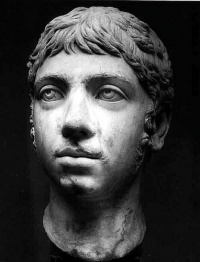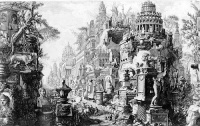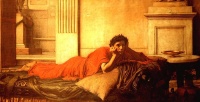Ancient Rome
From The Art and Popular Culture Encyclopedia
| Revision as of 22:42, 15 July 2009 Jahsonic (Talk | contribs) ← Previous diff |
Revision as of 22:46, 15 July 2009 Jahsonic (Talk | contribs) Next diff → |
||
| Line 9: | Line 9: | ||
| Roman civilization is often grouped into "[[classical antiquity]]" with [[ancient Greece]], a civilization that inspired much of the [[culture of ancient Rome]]. Ancient Rome contributed greatly to the development of [[law]], [[war]], [[art]], [[literature]], [[architecture]], [[technology]] and [[language]] in the [[Western world]], and its [[history of Rome|history]] continues to have a major influence on the world today. | Roman civilization is often grouped into "[[classical antiquity]]" with [[ancient Greece]], a civilization that inspired much of the [[culture of ancient Rome]]. Ancient Rome contributed greatly to the development of [[law]], [[war]], [[art]], [[literature]], [[architecture]], [[technology]] and [[language]] in the [[Western world]], and its [[history of Rome|history]] continues to have a major influence on the world today. | ||
| + | ==Roman decadence== | ||
| + | '''Roman decadence''' defines the gradual and moral decline in the [[ancient Roman]] republican values of family, farming, [[virtus (virtue)|virtus]], and [[Dignitas (Roman concept)|dignitas]]. | ||
| + | |||
| + | Some contemporary critics of Roman decadence, such as [[Cato the Younger]], attributed its rise to the influence of the Hellenistic philosophy [[epicureanism]], while modern historians such as [[Edward Gibbon]] ( ''[[The History of the Decline and Fall of the Roman Empire]]'', was published in six volumes between 1776 and 1788.) and Cyril Robinson also attribute increasing Roman affluence and the pacifying luxury it afforded. | ||
| + | |||
| + | According to [[Edward Gibbon]], the root of the decadence may lie in the political system. Especially mentioned is the lack of clear rules of succession. A significant number of successions involved bribing the army to be elected emperor, and a civil war between different declared emperors. This resulted in higher taxes and frequent destruction that provoked the apathy of the elite. | ||
| + | |||
| + | More controversially, the early history of the Christian church is also mentioned as a cause of decadence. The early Roman Empire was usually tolerant of the religion of the people conquered, and tried to preserve peace amongst its subjects. After the conversion of most of the Empire to Christianity, religious issues took a proiminent place in the political debate, sometimes leading to civil wars and later persecutions. | ||
| ==Symbols== | ==Symbols== | ||
| One of the symbols of Rome is the [[Colosseum]] (70-80), the largest [[amphitheatre]] ever built in the [[Roman Empire]]. Originally capable of seating 50,000 spectators, it was used for [[gladiator]]ial [[combat]]. The list of the very important monuments of ancient Rome includes the [[Roman Forum]], the [[Domus Aurea]], the [[Pantheon, Rome|Pantheon]], the [[Trajan's Column]], the [[Trajan's Market]], the [[Catacombs of Rome]], the [[Circus Maximus]], the [[Baths of Caracalla]], the [[Arch of Constantine]], the [[Pyramid of Cestius]], the [[Bocca della Verità]].{{GFDL}} | One of the symbols of Rome is the [[Colosseum]] (70-80), the largest [[amphitheatre]] ever built in the [[Roman Empire]]. Originally capable of seating 50,000 spectators, it was used for [[gladiator]]ial [[combat]]. The list of the very important monuments of ancient Rome includes the [[Roman Forum]], the [[Domus Aurea]], the [[Pantheon, Rome|Pantheon]], the [[Trajan's Column]], the [[Trajan's Market]], the [[Catacombs of Rome]], the [[Circus Maximus]], the [[Baths of Caracalla]], the [[Arch of Constantine]], the [[Pyramid of Cestius]], the [[Bocca della Verità]].{{GFDL}} | ||
Revision as of 22:46, 15 July 2009


|
Related e |
|
Featured: |
- The deification of Antinous, his medals, statues, temples, city, oracles, and constellation, are well known, and still dishonor the memory of Hadrian. Yet we remark, that, of the first fifteen emperors, Claudius was the only one whose taste in love was entirely correct. --Edward Gibbon
Ancient Rome was a civilization that grew from a small agricultural community founded on the Italian Peninsula circa the 9th century BC to a massive empire straddling the Mediterranean Sea. In its twelve-century existence, Roman civilization shifted from a monarchy, to a republic based on a combination of oligarchy and democracy, to an autocratic empire. It came to dominate Western Europe and the entire area surrounding the Mediterranean Sea through conquest and assimilation.
The Roman empire went into decline in the 5th century A.D. The western half of the empire, including Hispania, Gaul, and Italy, broke into independent kingdoms in the 5th century. The eastern empire, governed from Constantinople, is usually referred to as the Byzantine Empire after 476, the traditional date for the "fall of Rome" and for the subsequent onset of the Early Middle Ages, also known as the Dark Ages.
Roman civilization is often grouped into "classical antiquity" with ancient Greece, a civilization that inspired much of the culture of ancient Rome. Ancient Rome contributed greatly to the development of law, war, art, literature, architecture, technology and language in the Western world, and its history continues to have a major influence on the world today.
Roman decadence
Roman decadence defines the gradual and moral decline in the ancient Roman republican values of family, farming, virtus, and dignitas.
Some contemporary critics of Roman decadence, such as Cato the Younger, attributed its rise to the influence of the Hellenistic philosophy epicureanism, while modern historians such as Edward Gibbon ( The History of the Decline and Fall of the Roman Empire, was published in six volumes between 1776 and 1788.) and Cyril Robinson also attribute increasing Roman affluence and the pacifying luxury it afforded.
According to Edward Gibbon, the root of the decadence may lie in the political system. Especially mentioned is the lack of clear rules of succession. A significant number of successions involved bribing the army to be elected emperor, and a civil war between different declared emperors. This resulted in higher taxes and frequent destruction that provoked the apathy of the elite.
More controversially, the early history of the Christian church is also mentioned as a cause of decadence. The early Roman Empire was usually tolerant of the religion of the people conquered, and tried to preserve peace amongst its subjects. After the conversion of most of the Empire to Christianity, religious issues took a proiminent place in the political debate, sometimes leading to civil wars and later persecutions.
Symbols
One of the symbols of Rome is the Colosseum (70-80), the largest amphitheatre ever built in the Roman Empire. Originally capable of seating 50,000 spectators, it was used for gladiatorial combat. The list of the very important monuments of ancient Rome includes the Roman Forum, the Domus Aurea, the Pantheon, the Trajan's Column, the Trajan's Market, the Catacombs of Rome, the Circus Maximus, the Baths of Caracalla, the Arch of Constantine, the Pyramid of Cestius, the Bocca della Verità.


